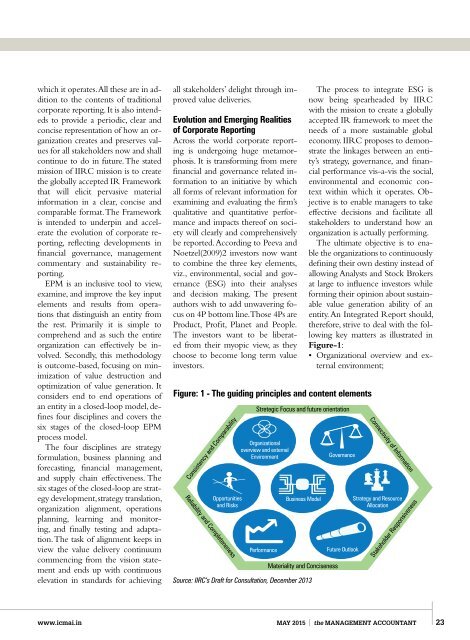May-2015
May-2015
May-2015
Create successful ePaper yourself
Turn your PDF publications into a flip-book with our unique Google optimized e-Paper software.
which it operates. All these are in addition<br />
to the contents of traditional<br />
corporate reporting. It is also intendeds<br />
to provide a periodic, clear and<br />
concise representation of how an organization<br />
creates and preserves values<br />
for all stakeholders now and shall<br />
continue to do in future. The stated<br />
mission of IIRC mission is to create<br />
the globally accepted IR Framework<br />
that will elicit pervasive material<br />
information in a clear, concise and<br />
comparable format. The Framework<br />
is intended to underpin and accelerate<br />
the evolution of corporate reporting,<br />
reflecting developments in<br />
financial governance, management<br />
commentary and sustainability reporting.<br />
EPM is an inclusive tool to view,<br />
examine, and improve the key input<br />
elements and results from operations<br />
that distinguish an entity from<br />
the rest. Primarily it is simple to<br />
comprehend and as such the entire<br />
organization can effectively be involved.<br />
Secondly, this methodology<br />
is outcome-based, focusing on minimization<br />
of value destruction and<br />
optimization of value generation. It<br />
considers end to end operations of<br />
an entity in a closed-loop model, defines<br />
four disciplines and covers the<br />
six stages of the closed-loop EPM<br />
process model.<br />
The four disciplines are strategy<br />
formulation, business planning and<br />
forecasting, financial management,<br />
and supply chain effectiveness. The<br />
six stages of the closed-loop are strategy<br />
development, strategy translation,<br />
organization alignment, operations<br />
planning, learning and monitoring,<br />
and finally testing and adaptation.<br />
The task of alignment keeps in<br />
view the value delivery continuum<br />
commencing from the vision statement<br />
and ends up with continuous<br />
elevation in standards for achieving<br />
all stakeholders’ delight through improved<br />
value deliveries.<br />
Evolution and Emerging Realities<br />
of Corporate Reporting<br />
Across the world corporate reporting<br />
is undergoing huge metamorphosis.<br />
It is transforming from mere<br />
financial and governance related information<br />
to an initiative by which<br />
all forms of relevant information for<br />
examining and evaluating the firm’s<br />
qualitative and quantitative performance<br />
and impacts thereof on society<br />
will clearly and comprehensively<br />
be reported. According to Peeva and<br />
Noetzel(2009)2 investors now want<br />
to combine the three key elements,<br />
viz., environmental, social and governance<br />
(ESG) into their analyses<br />
and decision making. The present<br />
authors wish to add unwavering focus<br />
on 4P bottom line. Those 4Ps are<br />
Product, Profit, Planet and People.<br />
The investors want to be liberated<br />
from their myopic view, as they<br />
choose to become long term value<br />
investors.<br />
The process to integrate ESG is<br />
now being spearheaded by IIRC<br />
with the mission to create a globally<br />
accepted IR framework to meet the<br />
needs of a more sustainable global<br />
economy. IIRC proposes to demonstrate<br />
the linkages between an entity’s<br />
strategy, governance, and financial<br />
performance vis-a-vis the social,<br />
environmental and economic context<br />
within which it operates. Objective<br />
is to enable managers to take<br />
effective decisions and facilitate all<br />
stakeholders to understand how an<br />
organization is actually performing.<br />
The ultimate objective is to enable<br />
the organizations to continuously<br />
defining their own destiny instead of<br />
allowing Analysts and Stock Brokers<br />
at large to influence investors while<br />
forming their opinion about sustainable<br />
value generation ability of an<br />
entity. An Integrated Report should,<br />
therefore, strive to deal with the following<br />
key matters as illustrated in<br />
Figure-1:<br />
• Organizational overview and external<br />
environment;<br />
Figure: 1 - The guiding principles and content elements<br />
Consistency and Comparability<br />
Reliability and Completeneness<br />
Opportunities<br />
and Risks<br />
Stretegic Focus and future orientation<br />
Organizational<br />
overview and external<br />
Environment<br />
Performance<br />
Business Model<br />
Materiality and Conciseness<br />
Source: IIRC’s Draft for Consultation, December 2013<br />
Governance<br />
Future Outlook<br />
Connectivity of Information<br />
Strategy and Resource<br />
Allocation<br />
Stakeholder Responsiveness<br />
www.icmai.in<br />
MAY <strong>2015</strong> the MANAGEMENT ACCOUNTANT 23


